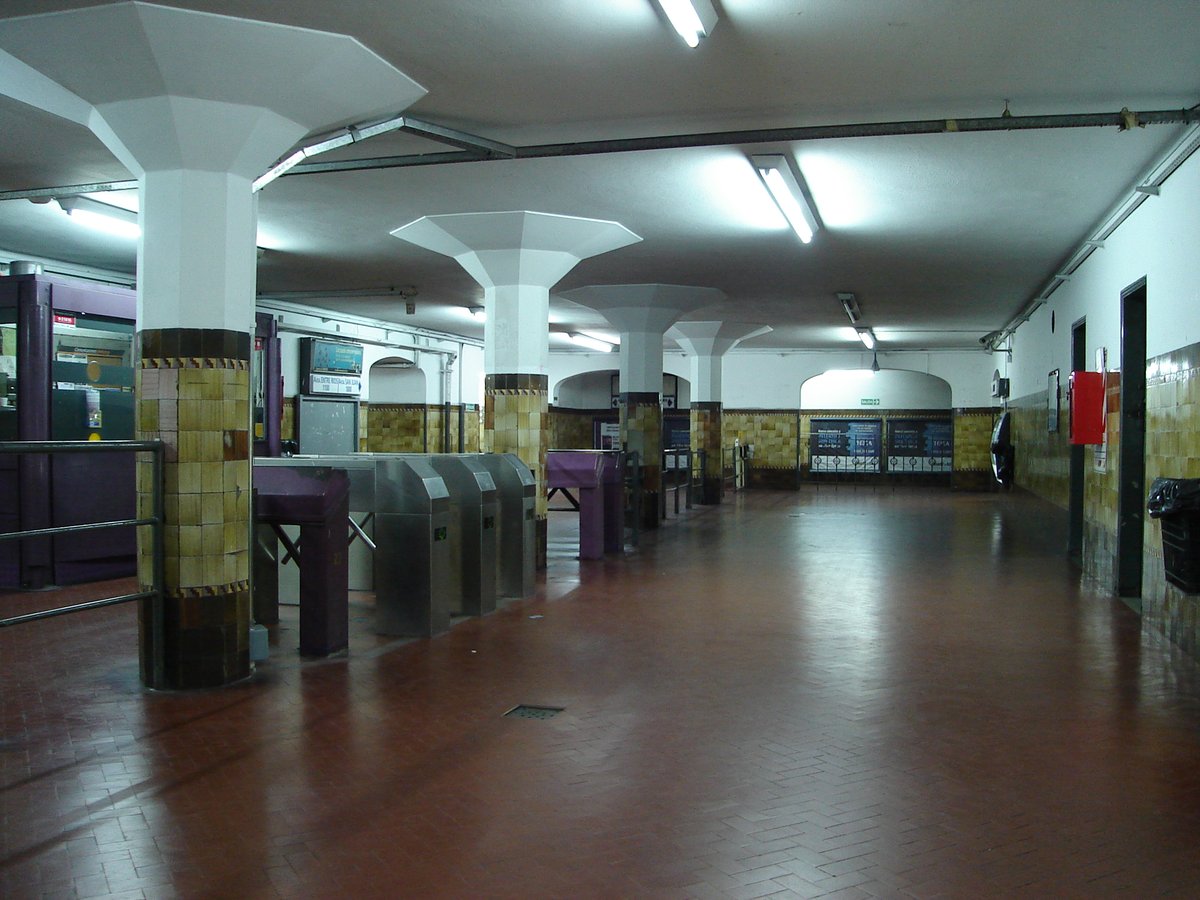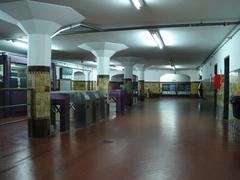
Complete Guide to Visiting Rodolfo Walsh Station in Buenos Aires: Tickets, Hours, and Nearby Attractions
Date: 15/06/2025
Introduction: The Significance of Rodolfo Walsh Station
Located beneath the lively intersection of Avenida San Juan and Avenida Entre Ríos, the Entre Ríos – Rodolfo Walsh station is much more than a transit stop on Line E of the Buenos Aires Subte. It serves as a living monument to Argentina’s history, art, and ongoing struggle for human rights. Opened in 1944 amid a period of rapid urban modernization, the station is renowned for its striking architecture and evocative murals that narrate pivotal moments in Argentine history. In 2013, the station was officially renamed to honor journalist and human rights activist Rodolfo Walsh, who was assassinated near this very spot during Argentina’s last military dictatorship.
This guide offers a comprehensive overview for travelers, history enthusiasts, and curious locals alike—from ticketing and accessibility details to a deeper understanding of the station’s cultural legacy and the many nearby attractions the neighborhoods of San Cristóbal and Constitución have to offer (Subte Buenos Aires; Subte de Buenos Aires Fandom; Ser Argentino; ESMA Museum Official Site).
Contents
- Origins and Construction
- Architectural and Artistic Heritage
- Monument Status and Historical Recognition
- Rodolfo Walsh: The Man Behind the Name
- Political Debates and Controversies
- Practical Visitor Information
- Accessibility and Travel Tips
- Nearby Attractions and Walking Routes
- Special Events and Guided Tours
- Frequently Asked Questions (FAQ)
- Key Historical Milestones
- Summary and Final Tips
Origins and Construction
Entre Ríos – Rodolfo Walsh station was inaugurated on June 20, 1944, as part of the original stretch of Line E, connecting Constitución with General Urquiza. Built by the Spanish firm CHADOPyF, the station was a keystone in Buenos Aires’ ambition to link its southern neighborhoods to the city center. The design features two lateral platforms and two tracks, reflecting the engineering standards of the era (Subte Buenos Aires; Subte de Buenos Aires Fandom).
Architectural and Artistic Heritage
The station stands out for its elegant mid-century architecture: white ceramic tiles brighten the platforms, while wrought iron details on ceilings evoke the cosmopolitan influences of pre-war Buenos Aires.
Most remarkable are the two monumental murals, based on 1939 sketches by Antonio Ortiz Echagüe and realized by Cattaneo y Compañía.
- “Fundación de pueblos en la Pampa” (Foundation of Towns in the Pampas) adorns the platform toward Plaza de los Virreyes.
- “La conquista del Desierto” (Conquest of the Desert) decorates the platform toward Bolívar.
These works, while iconic, also prompt reflection and debate over their depiction of Argentina’s expansion and its impact on indigenous communities (Subte de Buenos Aires Fandom).
Monument Status and Historical Recognition
In 1997, the station was declared a National Historic Monument, protecting its original murals, tiles, and design elements for future generations (Subte Buenos Aires).
Rodolfo Walsh: The Man Behind the Name
In March 2013, the Buenos Aires Legislature officially added “Rodolfo Walsh” to the station’s name to honor the renowned journalist, writer, and activist. Walsh was assassinated at this intersection on March 25, 1977, a day after his “Open Letter from a Writer to the Military Junta” exposed the regime’s crimes. Walsh’s legacy as a pioneer of investigative journalism—especially for his work “Operación Masacre”—remains foundational in Argentine and Latin American history (Ser Argentino; IFEX).
Political Debates and Controversies
The renaming of the station has sparked ongoing political debate. Libertarian and right-wing sectors have advocated for removing Walsh’s name, citing recent judicial findings and broader disputes over how Argentina remembers its dictatorial past. Protests and legislative proposals to revert to the original name reflect the broader national conversation on memory, justice, and reconciliation (ElDiarioAR).
Practical Visitor Information
Location: Beneath the intersection of Avenida Entre Ríos and Avenida San Juan, bordering San Cristóbal and Constitución.
Operating Hours: 5:30 AM – 11:30 PM weekdays; slightly reduced hours on weekends/holidays.
Tickets: Use a SUBE card (rechargeable and valid for all city transit). As of June 2025, a single Subte ride costs ARS 125. Cards are available at kiosks and convenience stores.
Accessibility: Elevators, escalators, tactile paving, audible announcements, and ramps ensure the station is accessible for all visitors.
Amenities: Restrooms, free Wi-Fi, information booths (Spanish/limited English), ATMs, and nearby shops.
Official Buenos Aires Subte Website
Accessibility and Travel Tips
- Best Times to Visit: Mid-morning or early afternoon for quieter visits and mural viewing.
- Photography: Permitted, but avoid flash to protect artwork and be courteous to passengers.
- Safety: Monserrat is generally safe by day. Watch for pickpockets during rush hour; keep valuables secure.
- Getting There: Line E connects to Lines A, C, and D; many buses stop nearby; taxis and apps like Uber/Cabify are widely used.
- What to Bring: SUBE card, water bottle, cash, and a crossbody bag.
Nearby Attractions and Walking Routes
- Plaza de Mayo: Historic heart of Buenos Aires, home to the Casa Rosada and Metropolitan Cathedral.
- San Telmo: Bohemian neighborhood renowned for its street markets, tango, and colonial architecture.
- Avenida 9 de Julio: Iconic avenue with the famed Obelisk and Teatro Colón.
- Parque Lezama: Historic park with sculptures and green spaces.
- Café Tortoni: Legendary café for a taste of Buenos Aires’ coffee culture.
Suggested Walking Route: Start at Entre Ríos – Rodolfo Walsh station, explore San Cristóbal and Constitución, then stroll toward San Telmo for markets and murals (Buenos Aires Tourism).
Special Events and Guided Tours
Cultural organizations occasionally host guided tours focusing on the station’s art and history. Check Buenos Aires cultural calendars or ask at station information points.
Frequently Asked Questions (FAQ)
Q: What are the station’s hours?
A: Open from 5:30 AM to 11:30 PM on weekdays, with reduced hours on weekends/holidays.
Q: How do I buy tickets?
A: Purchase and recharge SUBE cards at kiosks or convenience stores.
Q: Is the station accessible?
A: Yes, with modern elevators, ramps, and tactile guides.
Q: Can I take photos?
A: Yes, but be mindful of others and avoid flash.
Q: Are there guided tours?
A: Yes, though schedules vary; check with local tour providers.
Key Historical Milestones
- 1944: Station opens as part of Line E.
- 1977: Walsh is assassinated at the intersection above the station.
- 1997: Designated National Historic Monument.
- 2013: Renamed to honor Rodolfo Walsh.
- Recent years: Focal point of political debate about historical memory (Subte de Buenos Aires Fandom; ElDiarioAR).
Summary and Final Tips
Entre Ríos – Rodolfo Walsh station is a unique intersection of transit, art, and Argentina’s collective memory. Its murals, architecture, and commemorative plaques offer a window into the nation’s complex past and ongoing debates about identity and justice. As both a practical transit hub and a site of reflection, it provides visitors with a multifaceted cultural experience. To enhance your visit, consider exploring nearby historical neighborhoods, joining a guided tour, or visiting related sites such as the ESMA Museum (ESMA Museum Official Site). For real-time transit updates and audio tours, download the Audiala app.
Sources and Further Reading
- Subte Buenos Aires
- Subte de Buenos Aires Fandom
- Ser Argentino
- IFEX
- ElDiarioAR
- ESMA Museum Official Site
- Buenos Aires Tourism Official Site
- Wikipedia Entre Ríos – Rodolfo Walsh station
- Página 12 Article on Rodolfo Walsh






























































































































































